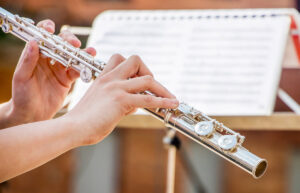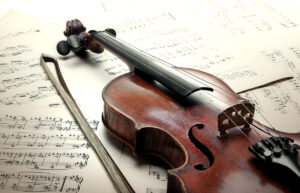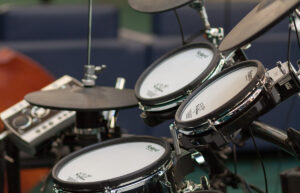How To Play Violin? Tips & Techniques

The violin is a captivating instrument that has captured the hearts and imaginations of musicians and audiences for centuries. Mastering the violin is a beautiful challenge. This guide offers a roadmap for beginners on how to play violin. It focuses on the learner’s experience and provides essential tips and techniques needed to become a skilled violin player.
Welcome to TheDemoStop, now join the community!
Connect with artists, fans and producers around the world.
Tips for Learning How To Play Violin
1: Gather Your Equipment
Before you learn how to play violin, you will need to gather the essential equipment. At a minimum, you will need the following items:
- Violin: Make sure to choose a violin that is the appropriate size for your body and playing ability.
- Violin bow: The bow draws sound from the violin strings. Look for a well balanced, high quality bow that feels comfortable in your hand.
- Rosin: This sticky substance is applied to the bow hair to create friction and improve the sound quality. It is an essential accessory that should be replenished regularly.
- Shoulder rest: This device helps support the violin on your shoulder, allowing for better posture and control.
- Tuner: An electronic tuner is a valuable tool for ensuring your violin stays in tune during practice and performance.
- Case: Protect your investment by storing your violin in a sturdy, well padded case when, not in use.
2: Find the Right Teacher
While it is possible to learn the violin through self study, having an experienced teacher can make a world of difference. A good violin instructor will provide personalized guidance, feedback and invaluable insights that can accelerate your progress. They can help you develop proper technique, address any bad habits and expand your musical understanding. When searching for a violin teacher, look for someone with a solid teaching track record, a patient and encouraging demeanor and a teaching style that aligns with your learning preferences.
3: Start with the basics
As a beginner, it is essential to master the fundamentals before moving on to more advanced techniques while learning how to play violin. This process includes understanding the different parts of the violin, learning how to hold the instrument and bow correctly and developing a solid foundation in basic playing techniques.
Familiarize yourself with the violin’s anatomy, including the fingerboard, strings, bridge, telpics and other key components. Knowing the names and functions of these parts will help you communicate more effectively with your teacher and make informed decisions about maintenance and care.
4: Posture
Proper posture is essential while learning how to play violin comfortably and efficiently. Whether you choose to stand or sit while playing, keep the following guidelines in mind:
- Spine alignment: Maintain a straight, upright posture with your shoulders relaxed and your heаd balanced evenly on top of your spine.
- Feet positioning: If standing, keep your feet shoulder width apart, with your weight evenly distributed. If sitting, sit toward the front of the chair with your left foot slightly ahead of your right.
- Violin placement: Rest the violin gently on your left shoulder, with the neck supported by your left hand. Keep the instrument parallel to the floor.
- Left hand: Curve your fingers around the neck of the violin, with your thumb and index finger forming a “C” shape.
- Right arm: Hold the bow with your right hand, keeping your elbow raised and your wrist flexible.
5: Bowing Technique
The bow is the primary tool you will use to produce sound on the violin, so developing a strong bowing technique is important. Start by mastering the basic bow strokes, focusing on maintaining a straight, even motion:
- Détaché: This is a basic, separate bow stroke, in which each note is played with a single, continuous bow movement.
- Staccato: Staccato bowing involves playing short, crisp notes by adding a sharp, accented attack at the beginning of each note.
- Legato: Legato playing refers to connecting notes smoothly, without any interruption in the bow movement.
- Spiccato: This step involves bouncing the bow on the strings to create a lively, springing effect.
- Ricochet: Also known as “bouncing bow,” this technique uses the bow’s natural rebound to play a series of rapid, repeated notes.
- Martelé: Martelé bowing features a strong, accented attack at the start of each note, creating a bold, expressive sound.
- Tenuto: Tenuto playing requires you to maintain the full duration of each note without shortening or interrupting the sound.
- Sautillé: Sautillé is a fast, bouncing bow stroke that creates a lively, energetic articulation.
Welcome to TheDemoStop, now join the community!
Connect with artists, fans and producers around the world.
6: Violin Care
Proper care and maintenance of your violin are essential for keeping it in top playing condition and ensuring a consistent, high-quality sound. Here аre sоme key tips for violin care:
- Bow maintenance: When not in use, be sure tо loosen the bow by turning the screw at the frog (the bottom part of the bow) counterclockwise. This measure helps prevent the bow hair from becoming overstretched and damaged.
- String replacement: Violin strings should be replaced after a few months, or when they start to sound dull or lose their pitch stability. Always replace one string at a time to avoid disrupting the violins setup.
- Storage and cleaning: When not playing, keep your violin safely stored in its case in a cool, dry and dark environment. Wipe down the instrument with a soft cloth after each practice session to remove any excess rosin or dirt.
- Professional maintenance: Occasionally, you may need to take your violin to a skilled luthier (a violin maker or repair specialist) for a professional setup or minor adjustments to ensure your instrument is playing at its best.
7: Tuning the Violin
Ensuring your violin is in tune is the first step to producing a clear, resonant sound. You can tune your violin using an electronic tuner or by ear.
8: Practice Daily
- Consistent, focused practice is the key to improving your violin skills. Try to practice the violin daily, even if it is just for a short 15-20 minute session. Over time, you can gradually increase your practice time as your skills improve.
- During your practice sessions, be sure to include a variety of exercises and techniques to address different aspects of your playing. Start with warm-up exercises, such as long tones and scales, to prepare your body and mind for more intensive work. Then, move to technique focused exercises, such as bow stroke variations and left hand finger exercises.
- Allocate time for sight reading, which will help improve your note reading skills and make you a more versatile player. Additionally, set aside time to work on specific pieces or passages that you’re trying to master.
- Remember to practice with intention and focus. Learning how to play violin requires discipline and focus. Avoid simply playing through pieces without addressing problem areas. Instead, identify your weaknesses and systematically work to improve them.
Conclusion
Tips for learning how to play violin
- Gather your equipment
- Violin
- Violin bow
- Rosin
- Shoulder rest
- Tuner
- Case
- Find the right teacher
- Start with the basics
- Posture
- Bowing technique
- Detaché
- Staccato
- Legato
- Spiccato
- Ricochet
- Martelé
- Tenuto
- Sautillé
- Violin care
- Tuning the violin
- Practice daily
FAQs
How do I hold the violin properly?
To hold the violin correctly, rest the instrument on your left shoulder, with the neck gripped gently by your left hand. Keep your back straight and your right elbow raised as you hold the bow. Your left fingers should curve around the neck, with your thumb and index finger forming a “C” shape.
How do I tune my violin?
You can tune your violin using an electronic tuner or by tuning it by ear. Start with the lowest string (G) and tune each string up to the highest (E) by adjusting the peg and matching the string’s pitch to the desired note.
How can I improve my bowing technique?
To improve bowing techniques, regularly practice basic bow strokes like détaché and martelé, focusing on maintaining even bow speed, pressure and placement on the strings. As you progress, experiment with more advanced techniques like spiccato and sautillé to expand your tonal palette.
How often should I practice the violin?
Try to practice the violin daily, if it is just for 15-20 minutes. Consistent, focused practice is key to improving your skills. As you advance, you can gradually increase your practice time to an hour or more per day.
How long does it take to learn the violin?
The time it takes to learn the violin can vary greatly depending on factors like your prior musical experience, the amount of time you practice and your natural aptitude. With regular, dedicated practice, most beginners can start playing simple tunes within 6 to 12 months.








































